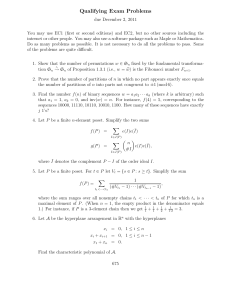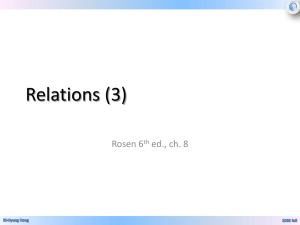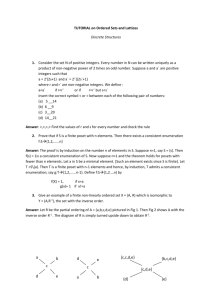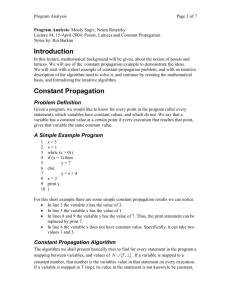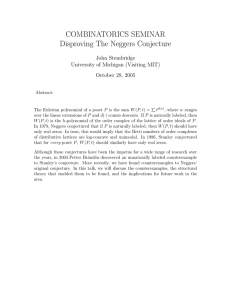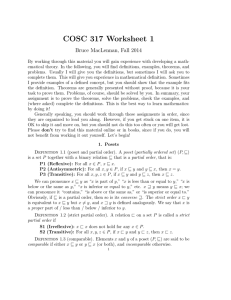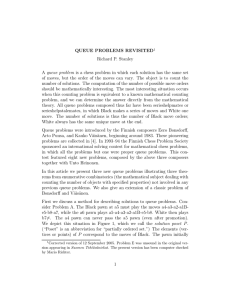4. Partial Orderings 4.1. Definition of a Partial Order. Definition 4.1.1.
advertisement
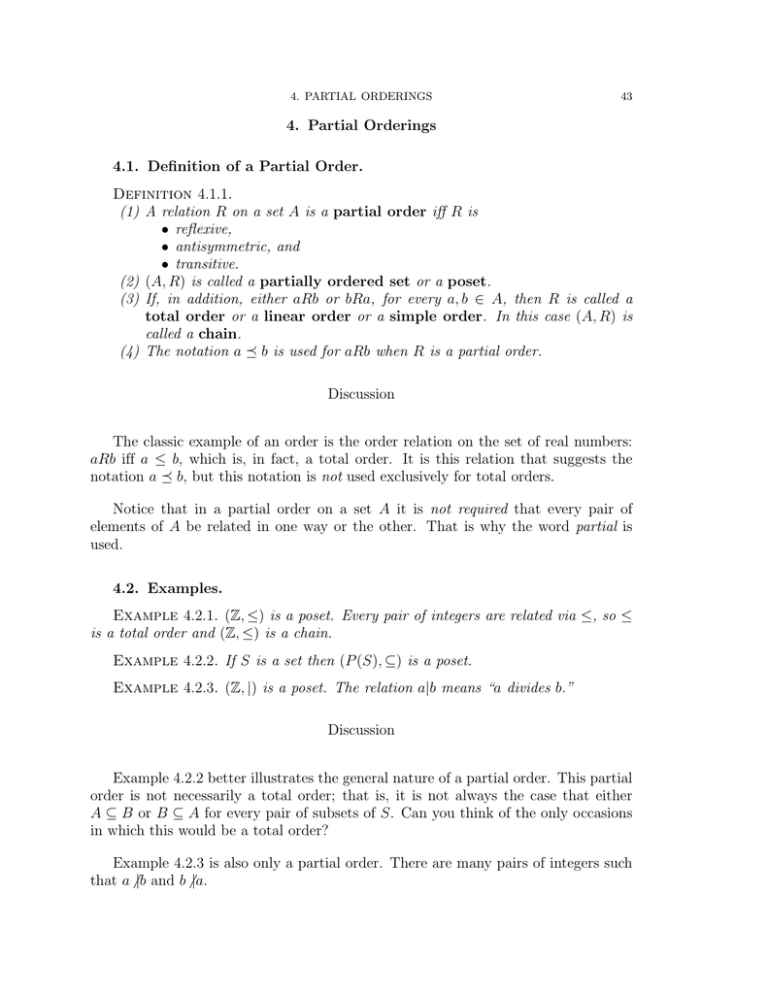
4. PARTIAL ORDERINGS
43
4. Partial Orderings
4.1. Definition of a Partial Order.
Definition 4.1.1.
(1) A relation R on a set A is a partial order iff R is
• reflexive,
• antisymmetric, and
• transitive.
(2) (A, R) is called a partially ordered set or a poset.
(3) If, in addition, either aRb or bRa, for every a, b ∈ A, then R is called a
total order or a linear order or a simple order. In this case (A, R) is
called a chain.
(4) The notation a b is used for aRb when R is a partial order.
Discussion
The classic example of an order is the order relation on the set of real numbers:
aRb iff a ≤ b, which is, in fact, a total order. It is this relation that suggests the
notation a b, but this notation is not used exclusively for total orders.
Notice that in a partial order on a set A it is not required that every pair of
elements of A be related in one way or the other. That is why the word partial is
used.
4.2. Examples.
Example 4.2.1. (Z, ≤) is a poset. Every pair of integers are related via ≤, so ≤
is a total order and (Z, ≤) is a chain.
Example 4.2.2. If S is a set then (P (S), ⊆) is a poset.
Example 4.2.3. (Z, |) is a poset. The relation a|b means “a divides b.”
Discussion
Example 4.2.2 better illustrates the general nature of a partial order. This partial
order is not necessarily a total order; that is, it is not always the case that either
A ⊆ B or B ⊆ A for every pair of subsets of S. Can you think of the only occasions
in which this would be a total order?
Example 4.2.3 is also only a partial order. There are many pairs of integers such
that a 6 |b and b 6 |a.
4. PARTIAL ORDERINGS
44
4.3. Pseudo-Orderings.
Definition 4.3.1.
A relation ≺ on S is called a pseudo-order if
• the relation is irreflexive and
• transitive.
Some texts call this a quasi-order. Rosen uses quasi-order to mean a different type
of relation, though.
Theorem 4.3.1 (Theorems and Notation).
(1) Given a poset (S, ), we define a relation ≺ on S by x ≺ y if and only if
x y and x 6= y. The relation ≺ is a pseudo-order.
(2) Given a set S and a pseudo-order ≺ on S, we define a relation on S by
x y if and only if x ≺ y or x = y. The relation is a partial order.
(3) Given a poset (S, ), we define the relation on S by x y iff y x.
(S, ) is a poset and is the inverse of .
(4) Given a set S and a pseudo-order ≺ on S, we define the relation on S by
x y iff y ≺ x. is a pseudo-order on S and is the inverse of ≺.
(5) In any discussion of a partial order relation , we will use the notations ≺,
, and to be the relations defined above, depending on . Similarly, if
we are given a a pseudo-order, ≺, then will be the partial order defined in
part 2.
Discussion
The notation above is analogous to the usual ≤, ≥, <, and > notations used
with real numbers. We do not require that the orders above be total orders, though.
Another example you may keep in mind that uses similar notation is ⊆, ⊇, ⊂, ⊃ on
sets. These are also partial and pseudo-orders.
Exercise 4.3.1. Prove a pseudo-order, ≺, is antisymmetric.
Exercise 4.3.2. Prove Theorem 4.3.1 part 1.
Exercise 4.3.3. Prove Theorem 4.3.1 part 2.
4.4. Well-Ordered Relation.
Definition 4.4.1. Let R be a partial order on A and suppose S ⊆ A.
(1) An element s ∈ S is a least element of S iff sRb for every b ∈ S.
(2) An element s ∈ S is a greatest element of S iff bSs for every b ∈ S.
4. PARTIAL ORDERINGS
45
(3) A chain (A, R) is well-ordered iff every nonempty subset of A has a least
element.
Discussion
Notice that if s is a least (greatest) element of S, s must be an element of S and
s must precede (be preceded by) all the other elements of S.
Confusion may arise when we define a partial order on a well-known set, such as
the set Z+ of positive integers, that already has a natural ordering. One such ordering
on Z+ is given in Example 4.2.3. As another example, one could perversely impose
the relation on Z+ by defining a b iff b ≤ a. With respect to the relation , Z+
would have no least element and it’s “greatest” element would be 1! This confusion
may be alleviated somewhat by reading a b as “a precedes b” instead of “a is less
than or equal to b”, especially in those cases when the set in question already comes
equipped with a natural order different from .
4.5. Examples.
Example 4.5.1. (Z, ≤) is a chain, but it is not well-ordered.
Example 4.5.2. (N, ≤) is well-ordered.
Example 4.5.3. (Z+ , ≥) is a chain, but is not well-ordered.
Discussion
In Example 4.5.1, the set of integers does not have a least element. If we look
at the set of positive integers, however, every nonempty subset (including Z+ ) has
a least element. Notice that if we reverse the inequality, the “least element” is now
actually the one that is larger than the others – look back at the discussion in Section
4.4 – and there is no “least element” of Z+ .
Pay careful to the definition of what it means for a chain to be well-ordered. It
requires every nonempty subset to have a least element, but it does not require that
every nonempty subset have a greatest element.
Exercise 4.5.1. Suppose (A, ) is a poset such that every nonempty subset of A
has a least element. Prove that is a total ordering on A.
4. PARTIAL ORDERINGS
46
4.6. Lexicographic Order.
Definition 4.6.1. Given two posets (A1 , 1 ) and (A2 , 2 ) we construct an induced or lexicographic partial order L on A1 × A2 by defining (x1 , y1 ) L (x2 , y2 )
iff
• x1 ≺1 x2 or
• x1 = x2 and y1 2 y2 .
This definition is extended recursively to Cartesian products of partially ordered sets
A1 × A 2 × · · · × A n .
Discussion
Exercise 4.6.1. Prove that if each of the posets (A1 , 1 ) and (A2 , 2 ) is a chain
and L is the lexicographic order on A1 × A2 , then (A1 × A2 , L ) is also a chain.
Exercise 4.6.2. Suppose for each positive integer n, (An , preceqn ) is a poset.
Give a recursive definition for the lexicographic order on A1 × A2 × · · · × An for all
positive integers n.
4.7. Examples 4.7.1 and 4.7.2.
Example 4.7.1. Let A1 = A2 = Z+ and 1 =2 = | (“divides”). Then
• (2, 4) L (2, 8)
• (2, 4) is not related under L to (2, 6).
• (2, 4) L (4, 5)
Example 4.7.2. Let Ai = Z+ and i = |, for i = 1, 2, 3, 4. Then
• (2, 3, 4, 5) L (2, 3, 8, 2)
• (2, 3, 4, 5) is not related under L to (3, 6, 8, 10).
• (2, 3, 4, 5) is not related under L to (2, 3, 5, 10).
Discussion
Notice that (2, 4) does not precede (2, 6): although their first entries are equal, 4
does not divide 6. In fact, the pairs (2, 4) and (2, 6) are not related in any way. On
the other hand, since 2|4 (and 2 6= 4), we do not need to look any further than the
first place to see that (2, 4) L (4, 5).
Notice also in Example 4.7.2, the first non-equal entries determine whether or not
the relation holds.
4. PARTIAL ORDERINGS
47
4.8. Strings. We extend the lexigraphic ordering to strings of elements in a poset
(A, ) as follows:
a1 a2 · · · am L b1 b2 · · · bn
iff
• (a1 , a2 , . . . , at ) L (b1 , b2 , . . . , bt ) where t = min(m, n), or
• (a1 , a2 , . . . , am ) = (b1 , b2 , . . . , bm ) and m < n.
Discussion
The ordering defined on strings gives us the usual alphabetical ordering on words
and the usual order on bit string.
Exercise 4.8.1. Put the bit strings 0110, 10, 01, and 010 in increasing order using
(1) numerical order by considering the strings as binary numbers,
(2) lexicographic order using 0 < 1,
There are numerous relations one may impose on products. Lexicographical order
is just one partial order.
Exercise 4.8.2. Let (A1 , 1 ) and (A2 , 2 ) be posets. Define the relation on
A1 × A2 by (a1 , a2 ) (b1 , b2 ) if and only if a1 1 b1 and a2 2 b2 . Prove is a partial
order. This partial order is called the product order.
4.9. Hasse or Poset Diagrams.
Definition 4.9.1. To construct a Hasse or poset diagram for a poset (A, R):
(1) Construct a digraph representation of the poset (A, R) so that all arcs point
up (except the loops).
(2) Eliminate all loops.
(3) Eliminate all arcs that are redundant because of transitivity.
(4) Eliminate the arrows on the arcs.
Discussion
The Hasse diagram of a poset is a simpler version of the digraph representing the
partial order relation. The properties of a partial order assure us that its digraph
can be drawn in an oriented plane so that each element lies below all other elements
it precedes in the order. Once this has been done, all redundant information can be
removed from the digraph and the result is the Hasse diagram.
4. PARTIAL ORDERINGS
48
4.10. Example 4.10.1.
Example 4.10.1. The Hasse diagram for (P ({a, b, c}), ⊆) is
{a,b,c}
{a,b}
{a}
{a,c}
{b,c}
{b}
{c}
Ø
Discussion
The following steps could be used to get the Hasse diagram above.
(1) You can see that even this relatively simple poset has a complicated digraph.
{a,b,c}
{a,b}
{b,c}
{a,c}
{a}
{b}
{c}
Ø
(2) Eliminate the loops.
4. PARTIAL ORDERINGS
49
{a,b,c}
{a,b}
{b,c}
{a,c}
{a}
{b}
{c}
Ø
(3) Now eliminate redundant arcs resulting from transitivity.
{a,b,c}
{a,b}
{b,c}
{a,c}
{a}
{b}
{c}
Ø
(4) Finally eliminate the arrows
4. PARTIAL ORDERINGS
50
{a,b,c}
{a,b}
{a,c}
{b,c}
{b}
{a}
{c}
Ø
Exercise 4.10.1. Construct the Hasse diagram for the poset ({1, 2, 3, 4, 6, 9, 12}, |),
where | is the “divides” relation.
Exercise 4.10.2. Is the diagram the Hasse diagram for a partial order? If so,
give the partial order and if not explain why.
(a)
(b)
i
f
i
h
g
c
d
a
f
e
c
b
h
g
d
e
b
4.11. Maximal and Minimal Elements.
Definition 4.11.1. Let (A, R) be a poset.
(1) An element a ∈ A is a minimal element if there does not exist an element
b ∈ A, b 6= a, such that b a.
(2) An element a ∈ A is a maximal element if there does not exist an element
b ∈ A, b 6= a, such that a b.
Discussion
4. PARTIAL ORDERINGS
51
Another useful way to characterize minimal elements of a poset (A, ) is to say
that a is a minimal element of A iff b a implies b = a. A similar characterization
holds for maximal elements. It is possible for a poset to have more than one maximal
and minimal element. In the poset in Exercise 4.10.1, for example, 1 is the only
minimal element, but both 9 and 12 are maximal elements. These facts are easily
observable from the Hasse diagram.
4.12. Least and Greatest Elements.
Definition 4.12.1. Let (A, ) be a poset.
(1) An element a ∈ A is the least element of A if a b for every element
b ∈ A.
(2) An element a ∈ A is the greatest element of A if b a for every element
b ∈ A.
Theorem 4.12.1. A poset (A, ) can have at most one least element and at most
one greatest element. That is, least and greatest elements are unique, if they exist.
Discussion
We revisit the definition of greatest and least elements, which were defined in
Section 4.4. As with minimal and maximal elements, Hasse diagrams can be helpful
in illustrating least and greatest elements. Although a poset may have many minimal
(or maximal) elements, Theorem 4.12.1 guarantees that it may have no more than
one least (or greatest) element. We ask you to explore the relationship among these
concepts in the following exercise.
Exercise 4.12.1. Let (A, ) be a poset.
(a) Prove that if a is the least element of A, then a is a minimal element of A.
(b) Prove that if b is the greatest element of A, then b is a maximal element of
A.
(c) Prove that if A has more than one minimal element, then A does not have a
least element.
(d) Prove that if A has more than one maximal element, then A does not have
a greatest element.
4.13. Upper and Lower Bounds.
Definition 4.13.1. Let S be a subset of A in the poset (A, ).
(1) If there exists an element a ∈ A such that s a for all s ∈ S, then a is
called an upper bound on S.
4. PARTIAL ORDERINGS
52
(2) If there exists an element a ∈ A such that a s for all s ∈ S, then a is
called an lower bound on S.
4.14. Least Upper and Greatest Lower Bounds.
Definition 4.14.1. Suppose (A, ) is a poset, S a is subset of A, and a ∈ A.
(1) a is
•
•
(2) a is
•
•
the least upper bound of S if
a is an upper bound of S and
if s is another upper bound of S, then a s.
the greatest lower bound of S if
a is an lower bound of S and
if s is another lower bound of S, then s a.
Discussion
In Section 4.13 we extend the concepts upper and lower bound as well as least
upper bound and greatest lower bound to subsets of a poset. The difference between
a least element of a subset of A and a lower bound for the subset of A is that the
least element is required to be in the subset and the lower bound is not. Here are
a few facts about lower bounds and minimal elements to keep in mind. You should
rephrase each statement replacing “lower” with “upper”, etc.
• For a to be a lower bound for a subset S, a need not be in S, but it must
precede every element of S.
• A minimal element, a, of a subset S is a lower bound for the set of all elements
in S preceded by a.
• A subset may have more than one lower bound, or it may have none.
• A subset may have lower bounds, but no greatest lower bound.
Example 4.14.1. Suppose we are given the poset (A, |), where A = {1, 2, 3, 4, 6, 8, 9, 12}.
(1)
(2)
(3)
(4)
The subset {2, 3, 4, 6} has no greatest or least element.
1 is the greatest lower bound for {2, 3, 4, 6} and 12 is its least upper bound.
The subset {1, 2, 3, 8} has no upper bound in A.
Every subset of A has a greatest lower bound.
Exercise 4.14.1. Consider the poset (A, ⊆), where A = P (S) is the power set
of a set S. Prove that every nonempty subset of A has a least upper bound and a
greatest lower bound in A.
4.15. Lattices.
Definition 4.15.1. A poset (A, ) is a lattice if every pair of elements has a
least upper bound and a greatest lower bound in A.
4. PARTIAL ORDERINGS
53
Discussion
To check if a poset is a lattice you must check every pair of elements to see if
they each have a greatest lower bound and least upper bound. If you draw its Hasse
diagram, you can check to see whether some pair of elements has more than one upper
(or lower) bound on the same level. If so, then the poset is not a lattice.
4.16. Example 4.16.1.
Example 4.16.1. The poset given by the following Hasse diagram is not a lattice.
e
d
c
b
a
Discussion
In Example 4.16.1 notice that {a, b} has upper bounds c, d and e. Since e is larger
than either c or d, it cannot be the least upper bound. But c and d are not related
in any way. Thus there is no least upper bound for the subset {a, b}.
Exercise 4.16.1. Prove that the poset (P (S), ⊆) is a lattice.
4.17. Topological Sorting.
Definition 4.17.1.
(1) A total ordering ≤ on a set A is said to be compatible with a partial ordering
on A, if a b implies a ≤ b for all a, b ∈ A.
(2) A topological sorting is a process of constructing a compatible total order
for a given partial order.
Discussion
A topological sorting is a process of creating a total order from a partial order.
Topological sorting has a number of applications. For example:
4. PARTIAL ORDERINGS
54
• It can be useful in PERT charts to determine an ordering of tasks.
• It can be useful in graphics to render objects from back to front to expose
hidden surfaces.
• A painter often uses a topological sort when applying paint to a canvas.
He/she paints parts of the scene furthest from the view first.
There may be several total orders that are compatible with a given partial order.
4.18. Topological Sorting Algorithm. procedure topological sort ((A, ):
finite poset)
k:= 1
while A 6= ∅
begin
ak := a minimal element of A
A:= A − {ak }
k:= k + 1
end {a1 , a2 , ..., an is a compatible total ordering of A}
Discussion
In order to justify the existence of a minimal element of S at each step in the
topological sorting algorithm, we need to prove Theorem 4.19.1 in Section 4.19.
4.19. Existence of a Minimal Element.
Theorem 4.19.1. Suppose (A, ) is a finite nonempty poset. Then A has a
minimal element.
Proof. Suppose (A, ) is a finite nonempty poset, where A has n elements,
n ≥ 1. We will prove that A has a minimal element by mathematical induction.
BASIS STEP. n = 1. Then A = {a} and a is a minimal (least!) element of A.
INDUCTION STEP. Suppose that every poset having n elements has a minimal
element. Suppose (A, ) is a poset having n + 1 elements. Let a be an arbitrary
element of A, and let S = A − {a}. Then S, together with the partial order restricted to S, is a poset with n elements. By the inductive hypothesis, S has a
minimal element b. There are two possibilities.
(1) a b. Then a is a minimal element of A. Otherwise, there is an element c
in A, different from a, such that c a. But then c is in S, c is different from
b (why?), and c b, which contradicts the fact that b is a minimal element
of S.
4. PARTIAL ORDERINGS
55
(2) a 6 b. Suppose b is not a minimal element of A. Then there is a c ∈ A with
c b. Since a 6 b we have c 6= a. Thus c ∈ S and we then conclude b is
not minimal in S. This is a contradiction so there are no elements of A that
preceed b. Hence b is a minimal element of A in this case.
Thus, in any case A has a minimal element, and so by the principle of induction every
finite poset has a minimal element.
Exercise 4.19.1. Let (A, A ) be a poset and let S ⊆ A. Define S on S by
∀a, b ∈ S[a S b ⇔ a A b].
Prove (S, S ) is a poset. The partial order S is the Restriction of A to S and
we usually use the same notation for both partial orders.
Example 4.19.1. Consider the set of rectangles T and the relation R given by
tRs if t is more distant than s from the viewer.
2
1
4
3
9
6
5
8
7
Here are some of the relations that we find from the figure: 1R2, 1R4, 1R3, 4R5, 3R2, 3R9, 3R6.
The Hasse diagram for R is
4. PARTIAL ORDERINGS
5
9
6
4
2
56
7
3
1
8
If we draw 1 (it would also be fine to use 8) out of the diagram and delete it we
get
5
9
6
4
2
7
3
8
Then draw 8
5
9
4
6
2
3
7
4. PARTIAL ORDERINGS
57
and so on. By drawing minimal elements you may get the following total order
(there are many other total orders compatible with the partial order):
7
2
6
9
5
3
4
8
1


